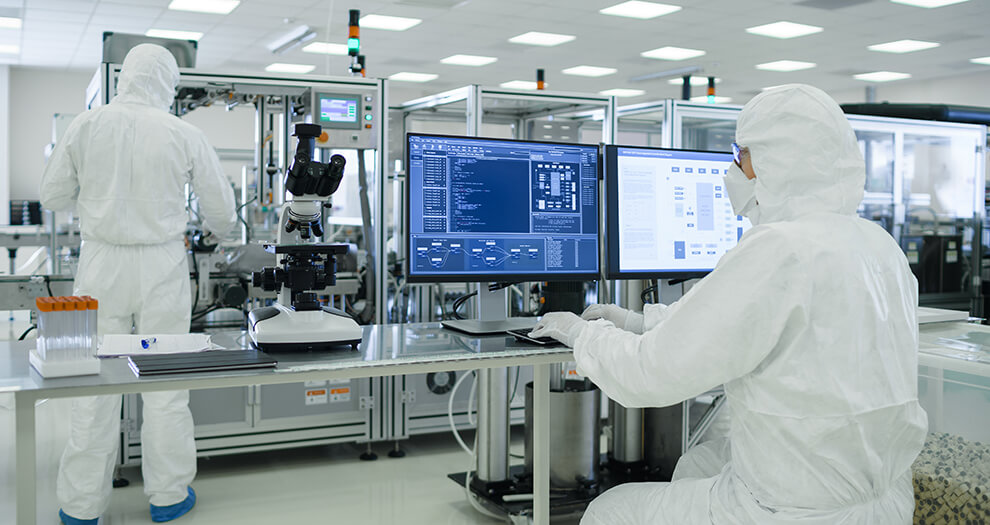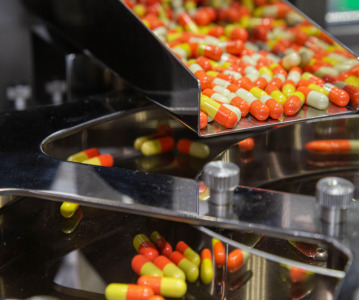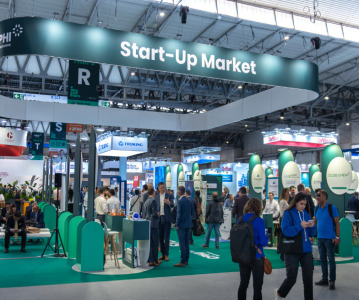Drug R&D innovation reshaping manufacturing and the CDMO sector

Our virtual CPHI Discover event (17th-28th May) is just around the corner, full to the brim with three main content tracks. Here, we explore the major trends and issues surrounding Manufacturing and Outsourcing.
Drug production is an ever evolving field with innovation being driven by the need to manufacture more effective therapies in a manner with is both cost and time efficient.
The traditional view is that the pharmaceutical industry is slower to adopt new manufacturing techniques than other sectors because of the need to validate processes with regulators. While this is true to an extent, in recent years drug firms have shown a greater willingness to embrace change (1).
In part the attitude change reflects growing acceptance of the benefits of newer production and processing methods. Continuous manufacturing – the process of making drugs on a constant basis rather than as specific separate batches – has gained in popularity in the past few years.
Regulatory support for new manufacturing techniques has also encouraged industry to adopt them. Again, continuous manufacturing is a good example; the US Food and Drug Administration has been advocating for the approach for several years (2).
More recently the United States Pharmacopeia (USP) and pharma start-up Phlow have built a laboratory that will develop test methods and standards for continuous manufacturing (3).
Hot melt extrusion (HME) is another manufacturing technique that is growing in popularity in the pharmaceutical sector. Originally developed for plastic and food production, HME is used by pharmaceutical firms to make formulations that enhance the solubility of APIs.
Another advantage of HME is that it can be used with a wide range of excipients – making it applicable to the production of a wide range of formulations. It is also straightforward to include analytical technology in HME processes.
Biopharma manufacturing
Analytical techs are also key to the evolution of biopharmaceutical manufacturing. Use of technologies like mass spectrometry has increased as biopharmaceutical companies have sought to increase their understanding of biological systems.
Likewise more drug companies in the large molecule space are using proteomic analysis to characterise the cell lines they used to manufacture protein-based medicines.
More generally the biopharmaceutical industry has embraced process analytical technologies (PAT) to model production processes in keeping with a shift towards quality-by-design (QbD).
Outsourcing
Pharmaceutical industry use of contract manufacturers has been increasing for several decades. Initially, drug companies handed over relatively simple, functional activities like fill-finish to contract manufacturing organisations (CMOs) in an effort to reduce costs and reduce internal capacity.
More recently the dynamic has changed with drug companies seeking contractors that offer a broader range of services or those that are willing to play a more strategic, longer-term role in production.
According to analysis (4) by PwC, demand for contractors offering strategic partnerships is increasing as pharmaceutical companies “shift their focus towards scientific research and pharmaceutical marketing.”
The authors say: “These co-operations can even lead to co-investments, as some pharmaceutical companies help finance specialised development and manufacturing facilities at strategic CDMOs.”
In the small molecule space, areas attracting investment at present include capabilities in the production of high potency APIs and continuous manufacturing.
Demand for CDMOs that can manufacture biopharmaceuticals and cell and gene therapies is also increasing. According to a recent study (5) the global biologics CDMO market, valued at $9.93 billion in 2020, will be worth $18.9 billion by 2026. The authors cite the drug industry’s development of cancer therapies as a major driver.
They also suggest growing interest in the use of mRNA for therapeutic development as another emerging dynamic.
CDMO sector dynamics
Shifting pharmaceutical industry demand is impacting the CDMO sector in other ways.
The CDMO sector has always been fragmented. According to PwC, 75% of the firms it classes in the contracting sector have revenues in excess of $50 million. In addition, the top five CDMOs hold only 15% of the market.
This – combined with growth of the strategic partnership model – is driving a wave of consolidation in the space with larger contractors buying rivals with niche capabilities to expend the range of services they offer.
In a recent report, EY (6) highlighted Lonza’s takeover of Capsugel and Thermo Fisher’s acquisition of Patheon as recent examples of capability driven M&A activity.
Another dynamic in the wider CDMO space is the number of drug companies beginning to offer contract manufacturing services.
The EY researchers cite Pfizer’s investment in its CentreOne operation and Sanofi’s expansion of CEPiA business as examples. They also point to Korean conglomerate Samsung’s entry into the space through its Samsung Biologics business as evidence of the opportunities in the industry.
Local sourcing
Concerns about the pharmaceutical industry’s reliance on overseas CDMOs have been growing in the US and Europe in recent years. For example, in 2019 (7) the FDA suggested local contractors could try to outcompete lower cost rivals based elsewhere by investing in advanced production systems.
The agency wrote, “Using traditional pharmaceutical manufacturing technology, a US-based company could never offset the labour and other cost advantages that China enjoys simply by achieving higher productivity.
“However, FDA believes that advanced manufacturing technologies could enable US-based pharmaceutical manufacturing to regain its competitiveness with China and other foreign countries, and potentially ensure a stable supply of drugs critical to the health of US patients.”
The COVID-19 pandemic has amplified these concerns. According to analysis (8) published last year, the temporary closure of CDMOs in India and China early last year increased material lead times from 6 to 8 weeks to 10 to 12 weeks.
The US Government Accountability Office (GAO) reached a similar conclusion, writing (9) that the pandemic “complicates the already challenged FDA foreign inspection programme.” Calls for pharmaceutical companies to source from local suppliers and contractors have increased significantly.
Register for CPHI Discover here and check out the agenda for details of upcoming webinars and podcasts
References:
- https://link.springer.com/article/10.1007/s11192-020-03707-y
- https://www.fda.gov/drugs/news-events-human-drugs/modernizing-way-drugs-are-made-transition-continuous-manufacturing
- https://www.europeanpharmaceuticalreview.com/news/150610/collaboration-to-encourage-us-adoption-of-continuous-manufacturing/
- https://www.pwc.de/de/gesundheitswesen-und-pharma/studie-pharma-cdmo-market.pdf
- https://www.europeanpharmaceuticalreview.com/news/150969/biologics-cdmo-market-to-double-in-value-by-2026-suggests-report/
- https://pdf4pro.com/download/the-pharmaceutical-cdmo-industry-is-consolidating-ey-3b06a3.html
- https://www.fda.gov/news-events/congressional-testimony/safeguarding-pharmaceutical-supply-chains-global-economy-10302019
- https://www.contractpharma.com/contents/view_experts-opinion/2020-06-29/the-covid-19-pandemic-sheds-light-on-the-over-reliance-on-offshore-drug-manufacturers/
- https://www.gao.gov/assets/gao-20-626t.pdf

Related News
-
News Pharmapack Awards 2024 Patient-Centric Design Award Winner – Dr Ferrer BioPharma
The 2024 Pharmapack Awards celebrated the best in innovation and design for the pharmaceutical packaging and drug delivery industry on January 24, 2024. -
News Women in Pharma: Minding the Gap at Pharmapack 2024
2024 marks the first year Pharmapack will host a Diversity track dedicated to bridging the gap within the pharmaceutical packaging and drug delivery sector. The track includes a panel discussion on 'Enabling Diversity in the Workplace,' focused... -
News Pharmapack Awards 2024 - Celebrating Packaging and Drug Delivery Innovation
The 2024 Pharmapack Innovation Awards ceremony celebrated the best in pharmaceutical packaging and drug delivery innovation at all levels. The awards were held on January 24, 2024 at the Paris Expo Porte de Versailles. -
News Pharmapack 2024 - From the Floor
Paris once again welcomes Europe’s leading trade show in pharmaceutical packaging and drug delivery innovation. Join our content team as Pharmapack 2024 opens its doors to leading experts and innovators in pharmaceutical packaging and drug delive... -
News CPHI Barcelona 2023: Partnering for Success – Managing Outsourcing Relationships to Optimise Manufacturing Operations
During CPHI Barcelona 2023, insightful content sessions offered attendees the chance to explore trending topics with expert speakers and panellists. Here, we summarise what the pharma industry and supply chain are talking about the most. -
News CPHI Barcelona 2023: Loading Potential – Artificial Intelligence for Pharma Manufacturing
During CPHI Barcelona 2023, insightful content sessions offered attendees the chance to explore trending topics with expert speakers and panellists. Here, we summarise what the pharma industry and supply chain are talking about the most. -
News Pharmaceutical industry supports COP28 health stance in joint statement
As COP28 takes place over this week in Dubai, UAE, several bodies in the pharmaceutical and health industries have come together to announce support of key movements in sustainability in the sector, and to recognise sustainability as a health issue.&nb... -
News CPHI Podcast Series: Start-ups take centre stage at CPHI Barcelona
The first episode of the CPHI Podcast Series since we attended CPHI Barcelona in October covers the Start-up market at the event, with expert Matthew Wise joining Editor Lucy Chard to discuss the event.
Position your company at the heart of the global Pharma industry with a CPHI Online membership
-
Your products and solutions visible to thousands of visitors within the largest Pharma marketplace
-
Generate high-quality, engaged leads for your business, all year round
-
Promote your business as the industry’s thought-leader by hosting your reports, brochures and videos within your profile
-
Your company’s profile boosted at all participating CPHI events
-
An easy-to-use platform with a detailed dashboard showing your leads and performance





.png)

